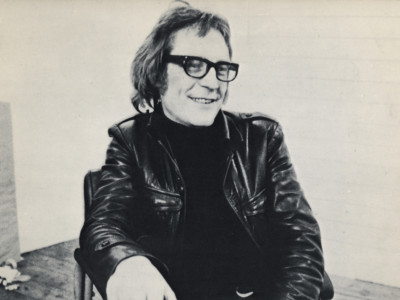
Meet the artist: Gabriele Münter
By Francesca Wade
Published on 8 October 2022
A founder member of the Blue Rider, the art group at the heart of German Expressionism, Münter developed a spontaneous painting method that captured the essence of things.
From the Autumn 2022 issue of RA Magazine, issued quarterly to Friends of the RA.
Francesca Wade is the author of Square Haunting: Five Women, Freedom and London Between the Wars (Faber). She is working on a book about Gertrude Stein.
In the summer of 1908, in a small market town in the foothills of the Alps, a group of friends sat painting outside in the sunshine, and the seeds of a new movement were sown. Among the group was Gabriele Münter, who came across Murnau with her lover and former teacher, Wassily Kandinsky; her paintings of its landscape – simplified forms darkly outlined and filled with bright, unmixed colours – presented an artistic breakthrough.
“After a short period of agony, I made a great leap,” she wrote in her diary that summer, “from copying from nature, in a more or less Impressionist style, to feeling the content of things – abstracting – conveying an extract.” The next year, she and Kandinsky became members of the New Artists’ Association (NKVM) in Munich, and later, in 1911, the Blue Rider, an important group of artists working towards the spontaneous, spiritually inflected vision she had first articulated that heady summer.

Born in Berlin in 1877, Münter awoke to the possibilities of documenting landscape during an 1898 trip to America with her sister – following the deaths of their parents – where she experimented with her first Kodak camera. At the Phalanx School in Munich in 1902 she met the Moscow- born Kandinsky, a teacher at the school, who soon invited her to join his summer classes in the Alps; she later wrote that the way he “regarded me as a consciously striving human being was a new artistic experience”. Over the course of their ensuing ten-year relationship they travelled around Europe and North Africa, but were constantly drawn back to the lakes and mountains of Murnau, where they regularly worked alongside their friends Alexei Jawlensky and Marianne Werefkin, Münter sometimes painting five canvases in a single day. Her work is deeply rooted in place, and her paintings of and around the Yellow House (their home in Murnau, known too as the Russians’ House) are imbued with a dynamism and joy that characterised the time they spent there. She often painted directly onto board, sketching in black outlines, then filling them in with broad strokes, leaving gaps of bare board in her eagerness to capture the scene before her, as can be seen at the edges of Three Houses in Murnau (1909), a scene that evokes the beauty of the area and the lives of its inhabitants hidden behind the open windows. “My pictures are all moments of life,” Münter once remarked. “I mean instantaneous visual experiences, generally noted very rapidly and spontaneously. When I begin to paint, it’s like leaping suddenly into deep waters, and I never know beforehand whether I will be able to swim.”

Through her life, her predominant style was figurative: her interiors, still-lifes, portraits and landscapes are characterised by the intensity of her colours and her bold forms, simplified down to their purest essence. Several of her still-lifes and interior scenes – friends chatting at breakfast or reclining in armchairs – feature her eclectic collection of folk objects, hanging on walls, as in Kandinsky and Erma Bossi at the Table (1909-10), which shows Bossi, another artist in the Royal Academy show, in their home in Murnau (Bossi’s Portrait of Marianne Werefkin, c.1910).
Kandinsky returned to Russia in 1914 after the outbreak of the First World War, while Münter travelled to Zurich and later Scandinavia. Following their painful separation, she painted many powerful portraits of women in interiors, gazing slightly beyond the viewer in ambiguous contemplation of their fates. We meet her now as the same confident artist of her own 1908 self-portrait, half her face occluded by darkness, but the other half bathed in a brilliant stream of light.

Making Modernism: Paula Modherson-Becker, Käthe Kollowitz, Gabriele Münter and Marianne Werefkin The Gabrielle Jungels-Winkler Galleries, Royal Academy of Arts, 12 Nov-Feb 2023. Supported by BNP Paribas with additional support from the Huo Family Foundation, The Tavolozza Foundation, and the International Music and Art Foundation.

Enjoyed this article?
As well as free entry to all of our exhibitions, Friends of the RA enjoy one of Britain’s most respected art magazines, delivered directly to your door. Why not join the club?
Related articles

Visions from Ukraine
19 June 2024

10 RA Schools stories through the centuries
16 May 2024

In memoriam: Mick Moon RA
1 May 2024